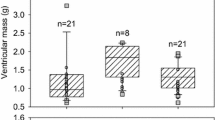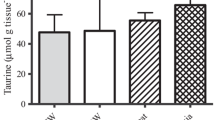Abstract
The influence of acute temperature change and temperature acclimation on the sensitivity of contracture development to ryanodine were examined in the rainbow trout myocardium using two preparations: in vitro isolated ventricular strips and in situ working perfused hearts. Ryanodine effects in vitro were dependent on test temperature (8 and 18 °C), pacing frequency (0.2–1.5 Hz) and acclimation temperature (8 and 18 °C). At a pacing frequency of 0.2 Hz and a test temperature of 18 °C, ryanodine depressed isometric tension development in ventricular strips both from trout acclimated to 8 and 18 °C but the decrease was significantly greater in strips from 8 °C-acclimated trout. No ryanodine effect was observed in either acclimation group at a test temperature of 8°C. The effect of ryanodine in vitro was reduced or lost at pacing frequencies greater than 0.2 Hz and at 0.6 Hz ryanodine depressed tension development at 18 °C only in strips from 8 °C-acclimated trout. Ryanodine did not affect tension development at stimulation rates above 0.6 Hz in any test group. Likewise, ryanodine did not significantly impair cardiac performance of in situ working perfused heart preparations which operated at intrinsic beat frequencies in excess of 0.6 Hz. These results suggest that the sarcoplamic reticulum calcium release channel of the trout myocardium is expressed but is not functionally involved in beat-to-beat regulation of contractility at either (1) low temperature (8 °C), or (2) at routine physiological heart rate (>0.6 Hz). However, under conditions in which involvement of the sarcoplasmic reticulum is observed (18 °C and a heart rate < 0.6 Hz), prior acclimation to low temperature results in either a greater capacity of the sarcoplasmic reticulum to store releasable calcium or an increase in the amount of calcium that is in releasable form.
Similar content being viewed by others
Abbreviations
- bm:
-
body mass
- E-C:
-
coupling, excitation-contraction coupling
- IVS:
-
isometric ventricular strip
- SR:
-
sarcoplasmic reticulum
- TES:
-
N-tris[hydroxy-methyl]methyl-2-aminoethane sulfonic acid
- WPH:
-
in situ working perfused heart
References
Bers DM (1987) Ryanodine and the calcium content of cardiac SR assessed by caffeine and rapid cooling contractures. Am J Physiol 253:C408-C415
Bers DM (1989) SR Ca loading in cardiac muscle preparations based on rapid cooling contractures. Am J Physiol 256:C109-C120
Driedzic WR, Gesser H (1988) Differences in force-frequency relationships and calcium dependency between elasmobranch and teleost hearts. J Exp Biol 140:227–241
El-Sayed MF, Gesser H (1989) Sarcoplasmic reticulum, potassium and cardiac force in rainbow trout and plaice. Am J Physiol 257:R599-R604
Farrell AP (1984) A review of cardiac performance in the teleost heart: intrinsic and humoral regulation. Can J Zool 62:523–536
Farrell AP, Bruce F (1987) Data acquisition and analysis of pulsatile signals using a personal computer: an application in cardiovascular physiology. Comput Biol Med 17:151–161
Farrell AP, Hammons AM, Graham MS, Tibbits GF (1988) Cardiac growth in rainbow trout,Salmo gairdneri. Can J Zool 66:2368–2373
Graham MS, Farrell AP (1989) The effect of temperature acclimation and adrenaline on the performance of a perfused trout heart. Physiol Zool 62:38–61
Holeton GF, Randall DJ (1967) The effect of hypoxia upon the partial pressure of gases in the blood and water afferent and efferent to the gills of rainbow trout. J Exp Biol 46:317–328
Hove-Madsen L (1992) The influence of temperature on ryanodine sensitivity and the force-frequency relationship in the myocardium of rainbow trout. J Exp Biol 167:47–60
Hove-Madsen L, Gesser H (1989) Force frequency relation in the myocardium of rainbow trout. J Comp Physiol B 159:61–69
Howell BJ, Baumgardner FW, Bondi K, Rahn H (1970) Acid-base balance in cold-blooded vertebrates as a function of body temperature. Am J Physiol 218:600–606
Keen JE, Farrell AP, Tibbits GF, Brill RW (1992) Cardiac physiology in tunas. II. Effect of ryanodine, calcium, and adrenaline on force-frequency relationships in atrial strips from skipjack tuna,Katsuwonus pelamis. Can J Zool 70:1211–1217
Keen JE, Vianzon D-M, Farrell AP, Tibbits GF (1993) Thermal acclimation alters both adrenergic sensitivity and adrenoceptor density in cardiac tissue of rainbow trout. J Exp Biol 181:27–47
Kiceniuk JW, Jones DR (1977) The oxygen transport system in trout (Salmo gairdneri) during sustained exercise. J Exp Biol 69:247–260
McArdle HJ, Johnston IA (1980) Evolutionary temperature adaptation of fish sarcoplasmic reticulum. J Comp Physiol 135:157–164
Milligan CL, Graham MS, Farrell AP (1989) The response of trout red cells to adrenaline during seasonal acclimation and changes in temperature. J Fish Biol 35:229–236
Møller-Nielsen T, Gesser H (1992) Sarcoplasmic reticulum and excitation-contraction coupling at 20 and 10 °C in rainbow trout myocardium. J Comp Physiol B 162:526–534
Penney RK, Goldspink G (1980) Temperature adaptation of sarcoplasmic reticulum of fish muscle. J Therm Biol 5:63–68
Pessah IN, Waterhouse AL, Casida JE (1985) The calcium ryanodine receptor complex of skeletal and cardiac muscle. Biochem Biophys Res Commun 128:449–456
Railo E, Nikinmaa M, Soivio A (1985) Effects of sampling on blood parameters in the rainbow trout,Salmo gaidneri Richardson. J Fish Biol 26:725–732
Randall DJ, Cameron JN (1973) Respiratory control of arterial pH as temperature changes in rainbow troutSalmo gairdneri. Am J Physiol 225:997–1002
Shattock MJ, Bers DM (1987) The inotropic response to hypothermia and the temperature-dependence of ryanodine action in isolated rabbit and rat ventricular muscle: implications for E-C coupling. Circ Res 61:761–771
Sitsapesan R, Montgomery RAP, MacLeod KT, Williams AJ (1991) Sheep cardiac sarcoplasmic reticulum calcium-release channels: modification of conductance and gating by temperature. J Physiol (London) 434:469–488
Sutko JL, Kenyon JL (1983) Ryanodine modification of cardiac muscle responses to potassium-free solutions. J Gen Physiol 82:385–404
Tibbits GF, Kashihara H, Thomas MJ, Keen JE, Farrell AP (1990) Ca2+-transport in myocardial sarcolemma from rainbow trout. Am J Physiol 259:R453-R460
Vornanen M (1989) Regulation of contractility of the fish (Carassius carassius L.) heart ventricle. Comp Biochem Physiol 94C:477–483
Author information
Authors and Affiliations
Rights and permissions
About this article
Cite this article
Keen, J.E., Vianzon, D.M., Farrell, A.P. et al. Effect of temperature and temperature acclimation on the ryanodine sensitivity of the trout myocardium. J Comp Physiol B 164, 438–443 (1994). https://doi.org/10.1007/BF00714580
Accepted:
Issue Date:
DOI: https://doi.org/10.1007/BF00714580




